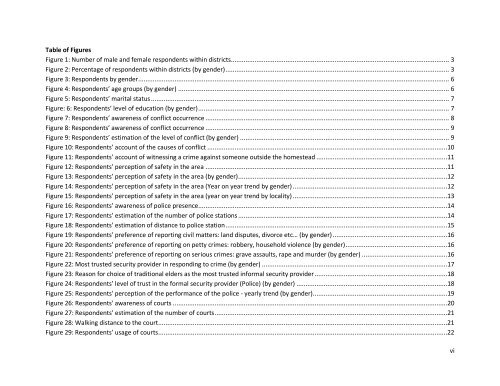Eastern Zone DCSA
Eastern Zone DCSA
Eastern Zone DCSA
Create successful ePaper yourself
Turn your PDF publications into a flip-book with our unique Google optimized e-Paper software.
Table of Figures<br />
Figure 1: Number of male and female respondents within districts ........................................................................................................................ 3<br />
Figure 2: Percentage of respondents within districts (by gender) ........................................................................................................................... 3<br />
Figure 3: Respondents by gender ........................................................................................................................................................................... 6<br />
Figure 4: Respondents’ age groups (by gender) ..................................................................................................................................................... 6<br />
Figure 5: Respondents’ marital status .................................................................................................................................................................... 7<br />
Figure: 6: Respondents’ level of education (by gender) .......................................................................................................................................... 7<br />
Figure 7: Respondents’ awareness of conflict occurrence ...................................................................................................................................... 8<br />
Figure 8: Respondents’ awareness of conflict occurrence ...................................................................................................................................... 9<br />
Figure 9: Respondents’ estimation of the level of conflict (by gender) ................................................................................................................... 9<br />
Figure 10: Respondents’ account of the causes of conflict ....................................................................................................................................10<br />
Figure 11: Respondents’ account of witnessing a crime against someone outside the homestead ........................................................................11<br />
Figure 12: Respondents’ perception of safety in the area .....................................................................................................................................11<br />
Figure 13: Respondents’ perception of safety in the area (by gender) ...................................................................................................................12<br />
Figure 14: Respondents’ perception of safety in the area (Year on year trend by gender) .....................................................................................12<br />
Figure 15: Respondents’ perception of safety in the area (year on year trend by locality) .....................................................................................13<br />
Figure 16: Respondents’ awareness of police presence .........................................................................................................................................14<br />
Figure 17: Respondents’ estimation of the number of police stations ...................................................................................................................14<br />
Figure 18: Respondents’ estimation of distance to police station ..........................................................................................................................15<br />
Figure 19: Respondents’ preference of reporting civil matters: land disputes, divorce etc… (by gender) ...............................................................16<br />
Figure 20: Respondents’ preference of reporting on petty crimes: robbery, household violence (by gender) ........................................................16<br />
Figure 21: Respondents’ preference of reporting on serious crimes: grave assaults, rape and murder (by gender) ...............................................16<br />
Figure 22: Most trusted security provider in responding to crime (by gender) ......................................................................................................17<br />
Figure 23: Reason for choice of traditional elders as the most trusted informal security provider .........................................................................18<br />
Figure 24: Respondents’ level of trust in the formal security provider (Police) (by gender) ...................................................................................18<br />
Figure 25: Respondents' perception of the performance of the police - yearly trend (by gender) ..........................................................................19<br />
Figure 26: Respondents' awareness of courts .......................................................................................................................................................20<br />
Figure 27: Respondents’ estimation of the number of courts ................................................................................................................................21<br />
Figure 28: Walking distance to the court ...............................................................................................................................................................21<br />
Figure 29: Respondents’ usage of courts ...............................................................................................................................................................22<br />
vi


